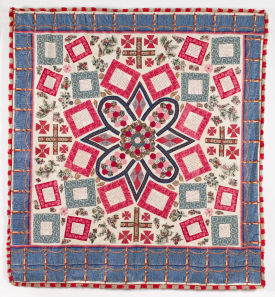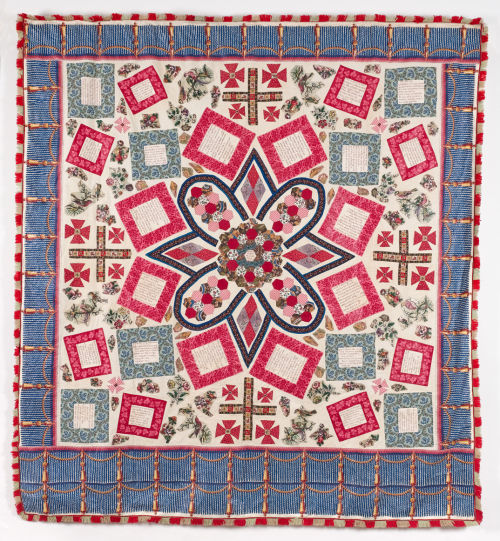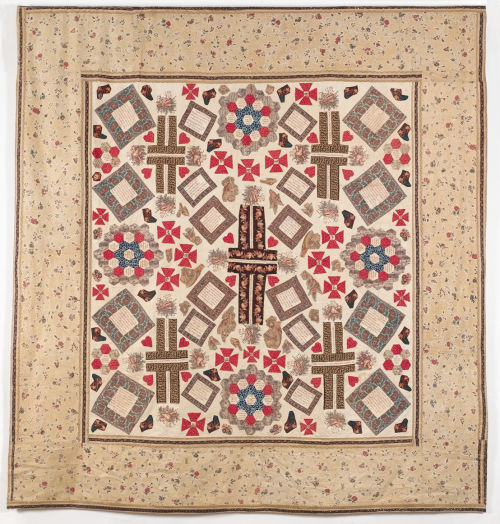October Quilt of the Month - Bloomfield and Wyatt Coverlets
Published: Monday, 1st October 2012 00:01 AM

October Quilt of the Month - The Bloomfield and Wyatt coverlets
The Quilters’ Guild Collection has two very distinctive and intriguing coverlets – the Edwin and Mary Bloomfield Coverlet, dated 1850 and the William Wyatt Coverlet, dated 1849. The similar design and some of the same fabrics present in both indicated a close connection between the two.
A detailed analysis of the coverlets and an in-depth exploration of the family history can be found in Quilt Studies Issue 9 and 10, with research and articles written by BQSG members Carolyn Ferguson and Margareta Faust.
Both coverlets are very unusual in their design. Each is meticulously appliquéd with verses of religious text, hand sewn in red cross stitch and applied onto the backing in printed cotton framed borders. Both also contain hexagons organised into rosettes, distinctive Maltese crosses patchwork motifs and even share some of the same fabric. The Bloomfield Coverlet contains fabric dating fairly close to its time of construction. The border fabric of swags and tassels was popular in the 1840s, and it is presumed that, as all of the fabrics are from a very similar date, many could have been bought especially for the coverlet. The Wyatt Coverlet is slightly different and contains fabric from a range of different dates, including a border fabric that dates from the late 18th century.
Family History
The similarities all pointed to coverlets that had been made by the same person, or within a family group, where the design and fabrics could have been shared. Family history research revealed the Bloomfield Coverlet to originate in Great Glemham, Suffolk. Edwin Bloomfield married Mary Newson on 4 January 1827, and had six daughters and three sons, the eldest of whom became a clergyman, with the other two following careers in the army. The extensive family home, The Grove, now a Grade II listed building, attests to the wealth and status of the family, and increases the likelihood of the coverlet’s origins. This quilt was clearly made by a family of good means with leisure time for sewing. The Wyatt coverlet proved much harder to research as the name is much more common, but it was found that William Wyatt married Anne Newson in 1840 in Brantham, Essex. William was a clergyman, and Anne had been left a large sum of money per year from her father after his death in 1843, which would have been a valuable asset to her household. Through tracing the family tree of both coverlets, it can be seen that Anne and Mary were sisters – proving the family link even though they may have lived in completely different parts of the country.
Religious Texts
The coverlets are both noted for their abundance of religious texts, and the excerpts on the Bloomfield Coverlet indicate the loss of a child. Many of the verses are dedicated to mourning parents, and research shows that both families lost children. Edwin and Mary lost two children, Thomas Newson Bloomfield, aged 9 in 1837 and Matilda Caroline Bloomfield in infancy, in 1831 and Anne and William lost their eldest son, Thomas Edward Wyatt in infancy, in 1848. At this time it was common to embroider pious quotes and religious texts onto everyday objects such as coverlets, and religion itself played an important role in the lives of Victorian households. Verses from hymns and prayers were often used on samplers and it was thought these would provide good advice for young women to learn and follow.
The discovery of a third quilt in Nottingham, which is very similar in style yet much less accurately constructed, has led to speculations of further links and the possibility of general trends that show this type and design of quilt was a popular way to commemorate loved ones and perhaps even seek some comfort and solace.
 The Edwin and Mary Bloomfield Coverlet
The Edwin and Mary Bloomfield Coverlet
 William Wyatt Coverlet
William Wyatt Coverlet